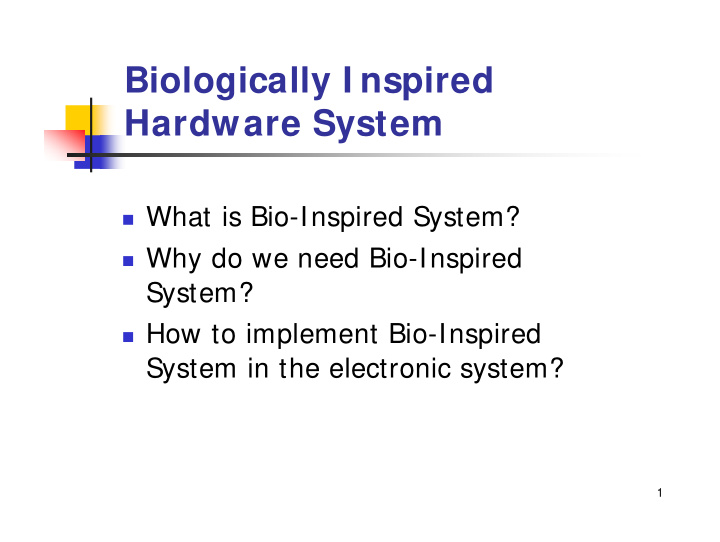



Biologically I nspired Hardware System � What is Bio-Inspired System? � Why do we need Bio-Inspired System? � How to implement Bio-Inspired System in the electronic system? 1
What is Bio-Inspired System? � It is a kind of artificial systems which uses the basic principles developed by nature. � Bio-Inspired hardware system relates the natural principles with the capabilities of electronic system. 2
Why do we need Bio-Inspired System? � Electronic systems are increasingly used in safety critical system. � A safety critical system demands the electronic system have a very low failure rate and fault tolerance. � Bio-Inspired systems have inherent fault tolerance due to their adaptive native. 3
How to implement Bio-Inspired system in the electronic system? � Reconfigurable Hardware, such as FPGAs, make it possible to implement Bio-Inspired system in the electronic system. 4
Bio-Inspired Hardware System � The POE Model � Embryonics � Immunotronics � Immuno-Embryonics 5
The POE Model (1) � There are three methods of life progression on earth have been identified: Phylogeny � Phylogeny (P) (Evolution) � Ontogeny (O) Ontogeny � Epigenesis (E) (Development) Epigenesis (Learing) 6
The POE Model (2) � The space of Bio-Inspired systems were plotted along three axes: Phylogeny (P), Ontogeny (O), and Epigenesis. 7
Embryonics: (1) � Embryonics is inspired by the embryonic development of living beings. (embryological electronics) � Embryonics attempts to use the features of nature to develop a new family of multi- cellular FPGAs that will show the properties of self-repair and self-healing. 8
Embryonics: (2) � There are two group researchers who are currently developing the embryonics system: � Swiss Federal Institute of Technology; � University of York. 9
Embryonics: (3) � The four layers of the Embryonics project undertaken by the Swiss Federal Instite of Techonology. � Population level; � Organismic level; � Cellular level; � Molecular level. 10
Embryonics: (4) ROUTING UNIT GENOME Interpreter MEMORY Coords X, Y FUNC UNIT 11
Embryonics: (5) � The two layers of the Embryonics project undertaken by University of York: � Organismic level; � Cellular level. 12
13 Embryonics: (6)
Embryonics: (7) � Embryonics system can achieve the three fundamental features � Multi-cellular organisation; � Cellular division; � Cellular differentiation. 14
Self-repair: � Embryonics system can realize the function of self-repair on the intra- cellular level with reconfiguration. � Reconfiguration strategies: � Row-elimination � Cell/Molecule-elimination 15
Row-elimination 3 3 3 3 3 3 3 3 2 2 2 2 2 2 2 2 2 2 2 2 1 1 1 1 1 1 1 1 1 1 1 0 0 0 0 0 0 0 0 0 0 0 0 Transparent Active Cell Spare Cell Cell a) Healthy array b) Fail in one cell c) Healing achieved 16
Cell-elimination 7 8 9 7 8 9 7 8 9 7 8 9 4 5 6 4 5 6 4 5 6 4 5 6 1 2 3 1 2 3 1 2 3 1 2 3 Active Cell Spare Cell Transparent Cell 17
Human Immune System � The human immune system can recognise and attack any foreign cell or molecule: � It has independent network in the body; � It is distributed all the body; � It can learn and remember from past experiences what it should attack. 18
Immunotronics (1) � Immuntronics (immunological electronics) is a new area of bio-inspired hardware system. � It uses immune system to detect and correct the faults in electronic hareware. 19
Immunotronics (2) � How to distinguish between self and non- self status of cells? � In electronic system, the invading organisms can be considered as fault; � The self status is the normal operation; � The non-self status is the error operation or fault. 20
Immunotronics (3) � The steps of Immunotronics: � Data Gathering � Tolerance condition generation � Fault monitoring � Recovery 21
Immuno-Embryonics (1) � Immuno-Embryonics assembles the principles and ideas conceived in Immunotronics and Embryonics. � It uses antibody to detect the fault of embryonics cells. 22
Immuno-Embryonics (2) � Architecture of Immuno-Embryonics: � Use antibody cell to detect the embryonics cell. 23
Summary � Bio-Inspire hardware system can be classified with POE model. � There are two models implemented in electronic system: � Embryonics � Immuno-Embryonics 24
Future Work � Further study of digital system � Architecture design of novel electronic ‘cell’ � Design a multi-cellular architecture 25
Recommend
More recommend